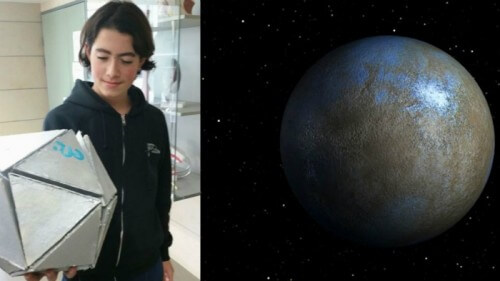Testing the feasibility of life on the clouds of Venus, mining minerals from an asteroid or planning a research mission to the dwarf planet Ceres. These are the challenges that middle school students who participated in the Ilan and Assaf Ramon Space Olympiad, which is held at the initiative of the Israel Space Agency at the Ministry of Science, had to face one of them

Testing the feasibility of life on the clouds of Venus, mining minerals from an asteroid or planning a research mission to the dwarf planet Ceres. These are the challenges that middle school students who participated in the Ilan and Assaf Ramon Space Olympiad, which is held at the initiative of the Israel Space Agency at the Ministry of Science, had to face one of them. 270 teams from all over the country participated in the competition. In the first stage they were required to answer a quiz, and in the second stage they were required to plan one of the starting tasks mentioned above. Of the outstanding teams, 14 qualified for the final stage, where they were required to further develop the task.
Twenty probes
The XNUMXth and XNUMXth grade students from the Boyar School in Jerusalem planned a complex mission to land on a hook, and shared the first prize with the Himmelfarb HT students, who also planned a mission to the dwarf planet. Boyer's spaceship is a decagon, an elaborate polygon consisting of twenty triangular pyramids (quadrons: a three-dimensional shape in which each side is an equilateral triangle), the length of the side in each pyramid is supposed to be two meters, and the total diameter of the decagon will be about five meters. "This shape is ideal for a space mission", explain the group's twin members Roy and Gilad Piro. "In the launch rocket, the quadruplets are stacked on top of each other, to fit a long and narrow structure. In the space station, the shape of the pyramid is assembled, which is adapted to flight in space, where there is no need for aerodynamics." Upon its arrival at Keres, the spacecraft is supposed to break up into twenty probes, each of them designed to study a different area on the dwarf planet: the study of the poles, the ocean, the equator and the atmosphere; and for various tasks such as searching for life and mining minerals. Three of the probes are supposed to return and take off, and serve as a satellite positioning system (GPS) for the other probes. In addition to the Piro brothers, the members of the group are Eli Schreiber, Daniel Polak, Gil Ezra, Or Tamir (pictured), Shaliu Shlomo, Yonatan Ashur and Raz Gov Ari. They were helped by the accompanying teacher Avishag Ben Yishai and the instructor Maor Madmon.
Pasta in space
The Space Olympics is indeed a competition, but first of all it is an educational event, which encourages the participants to gain knowledge in the fields of space and other sciences. "We studied a lot of physics for the purpose of development", confirms Gilad Piro. "We learned about reference systems, speeds, attack and momentum, weight and mass calculations, vectors. We also got to know Ceres in depth, and learned a lot about the asteroid belt. We worked in a very cohesive group, and learned about group dynamics and cooperation. It definitely made me want to learn more about space." To the question if he would like to be the first Israeli to land on a hook, Pirro replies "Flying in space is a bit scary, but being the first Israeli to design a spacecraft for a hook? With fun."
In addition to the physical and engineering aspects, the group was also required to present the economic feasibility of the task. According to them, there are estimates that many rare metals can be found on the surface of Keres, the result of its collision with an asteroid that created a huge crater. According to some estimates, the value of the minerals reaches tens of trillions of dollars, which makes the task very worthwhile, because its cost is estimated at only about 2.5 billion dollars.
Pyramids on a dwarf planet
The dwarf planet Ceres is the largest body in the asteroid belt between the orbits of Mars and Jupiter. It was discovered more than 200 years ago, in the observations of the Italian astronomer Giuseppe Piazzi, but until now it has not been photographed up close. Next month, the Dawn spacecraft is scheduled to come close to Ceres for the first time. In honor of the legacy of the Italian Piazzi, the Boyer students decided to call their spaceship "Spaghetti", with each probe bearing the name of a different pasta: ravioli, macaroni, linguine and so on. The prize for the winning teams: an elaborate telescope that will be placed on the roof of the school, from where they will be able to observe a hook, while filling the private stomach with pasta.
Ceres - the largest of the asteroids, a dwarf and almost unknown planet

One response
Each of these tasks is highly imaginative and feasible and better to be realized by the Israeli Space Agency than a foolish effort to send another Israeli astronaut into orbit around the Earth for a week by a foreign space agency.